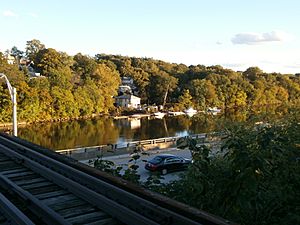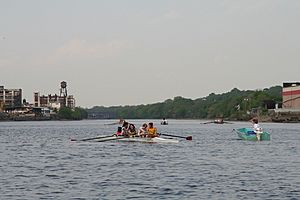Kearny Riverbank Park facts for kids
Kearny Riverbank Park is a public park located along the Passaic River in Kearny, New Jersey. It's a long, narrow park found in the northern part of Kearny, near Bergen Avenue. In 2011, the park was made even bigger, stretching to Belleville Turnpike. This expansion happened because old, unused industrial lands (called brownfields) were cleaned up and turned into park space. In 2012, the park received $1.8 million from the state of New Jersey to make its walking and biking paths even better.
The part of the Passaic River next to the park is very popular for rowing. Many high school rowing teams use this area. The park is home to a special building called a boathouse, which is used by student rowers from Kearny, Belleville, and Nutley.
Contents
Honoring Important People and Events
Many parts of Kearny Riverbank Park are named after important people or events from history. Some sections are named after local leaders who served as councilmen and mayors of Kearny. These include Norman A. Doyle, Henry J. Hill, Daniel T. Sansone, and Joseph M. Healey.
Special Dedications in the Park
- Keating Cove is named in honor of Bernard J. Keating.
- Wallace Glen remembers both Sir William Wallace, a famous Scottish hero, and Councilman David A. Wallace.
- Irish Heritage Park is dedicated to Reverend Monsignor Joseph A. Carroll.
- There is also a Centennial Orchard and a section dedicated to Christopher Columbus.
- Another part of the park is named in memory of the Battle of Chantilly. This is where the town's namesake, Philip Kearny, sadly lost his life in 1862 during the American Civil War.
In 2006, many of the signs that mark these special sections were replaced. This was done through a sponsorship program to help keep the park looking nice.
A Place for Veterans
While most of Kearny Riverbank Park runs alongside the river, there's a special area called Veterans Memorial Park that stretches further inland. This part of the park has a unique history. It was once the location of the New Jersey Home for Disabled Soldiers. This was a place where soldiers who had served their country and were no longer able to work could live and be cared for. It operated from 1888 to 1932.
After it closed, the 10-acre grounds were given to the town to be used as a public park. Many veterans from the American Civil War and the Spanish–American War are buried nearby in Arlington Memorial Park.
Images for kids







